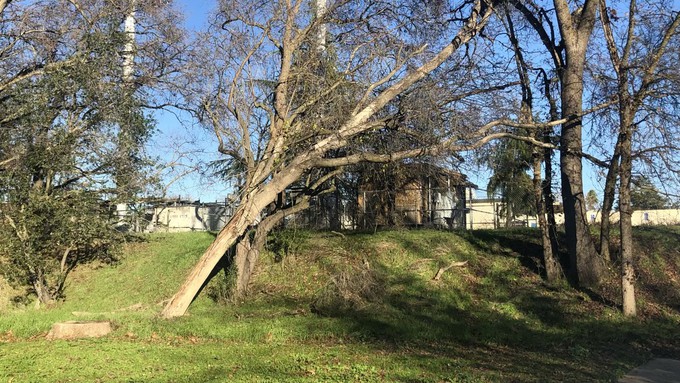
Watch for falling trees and branches

A park tree leans precariously after last weekend's storm. The sun was (briefly) out when it was photographed, but the tree could be in danger of falling during the next windy storm, starting Wednesday. Avoid driving or walking under trees if possible. Kathy Morrison
More wild weather is headed for Sacramento. And with this next round of rain come some powerful winds – and that could represent some real danger to our homes and gardens.
“Damaging winds will impact the region Wednesday and Thursday,” tweeted the Sacramento office of the National Weather Service. “Gather emergency supplies, charge your electronic devices, use generators outdoors, and keep refrigerators closed.”
In other words, be ready for more power outages due to downed power lines – and trees.
On Tuesday afternoon, the weather service issued a High Wind Warning for the greater Sacramento area, in effect from 10 a.m. Wednesday to 4 p.m. Thursday. That’s also when Sacramento can expect another inch or two of rain.
“Damaging winds will blow down trees and power lines,” says the wather service. “Widespread power outages are expected. Travel will be difficult, especially for high-profile vehicles.
“Saturated soils will allow trees to topple more easily during this wind event,” adds the warning. “The strongest winds will be Wednesday afternoon and into Thursday morning.”
Southerly winds will blow steadily from 25 to 30 mph, with gusts of 60 mph, predicts the weather service.
If you haven’t already, tie down or move anything that can be blown around by such gusts. Patio furniture can become missiles. Hanging plants can bash into windows. Large potted plants will be knocked over and rolled around.
Most destructive are falling branches and uprooted trees. The weather service warns residents to stay away from trees during this storm – and away from windows that could be broken.
Evergreen trees such as redwoods or cedars are at greater risk. Their foliage acts like a giant sail and catches the wind’s full force.
Before the storm, survey trees and large shrubs in your own landscape. Young trees may be stabilized with stakes or other supports; otherwise, their trunks and limbs may snap during this storm. More mature trees may need professional help.
For tips on tree care – before and after this storm – and how to hire an arborist, go to www.sactree.org.
For more on wind damage, consult these UC master gardener notes: https://ipm.ucanr.edu/PMG/GARDEN/ENVIRON/wind.html
-- Debbie Arrington
Comments
0 comments have been posted.Sacramento Digs Gardening to your inbox.
Sites We Like
Garden Checklist for week of July 21
Your garden needs you!
* Keep your vegetable garden watered, mulched and weeded. Water before 8 a.m. to reduce the chance of fungal infection and to conserve moisture.
* Feed vegetable plants bone meal, rock phosphate or other fertilizers high in phosphate to stimulate more blooms and fruiting. (But wait until daily high temperatures drop out of the 100s.)
* Don’t let tomatoes wilt or dry out completely. Give tomatoes a deep watering two to three times a week.
* Harvest vegetables promptly to encourage plants to produce more. Squash especially tends to grow rapidly in hot weather. Keep an eye on zucchini.
* Pinch back chrysanthemums for bushy plants and more flowers in September.
* Remove spent flowers from roses, daylilies and other bloomers as they finish flowering.
* Pinch off blooms from basil so the plant will grow more leaves.
* Cut back lavender after flowering to promote a second bloom.
* It's not too late to add a splash of color. Plant petunias, snapdragons, zinnias and marigolds.
* From seed, plant corn, pumpkins, radishes, winter squash and sunflowers.